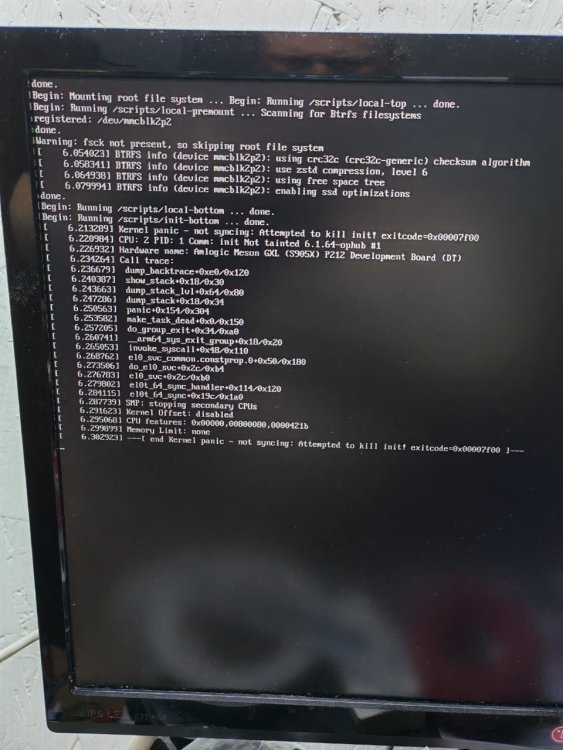All Activity
- Past hour
-
You are not using Armbian but a fork. Ask where you got the image from. We don't support 3rd party OS.
-
-

Expected default graphics acceleration for RK3588?
usual user replied to gpupoor's topic in Orange Pi 5 Plus
I have nothing to complain about and the VPUs are also working. classification-3.11.log fluster-run-odroid-m2-summary - Today
-

Expected default graphics acceleration for RK3588?
gpupoor replied to gpupoor's topic in Orange Pi 5 Plus
Thanks @KhanhDTP, this is great. I tried to stick with approaches that have made their way into official channels, but I'm happy to include because it's very cool to have a full working path identified (B2). I think I understood your setup but please let me know if I missed anything. Again, not sure where/how the best place to keep track of this is so in the absence of anything better I'll use the PR, but happy to migrate to another location. -
Really thank you for this!!! Just tested it today, using the provided "ready to go" ISO image. At first, system boots up Ok, and it automatically detects LAN Network , as I have an auto assigned IP shown in screen 😁 So this is (for me) a step up with the device (I have this one) as in my previous attemps with Armbian I couldn't manage to connect any network. Using armbian-config, I understand that WiFi also works... but... I couldn't connect. I can "see" all available Networks, and when I choose mine and enter password, the query (armbian-config) shows an error about the yaml file (I understand this is the configuration file). I did a quick test, and as I had wired netwrok I moved on. A little note: check the pictures in my device and WiFi Chip is LGX8800D, for sure somthing from the AIC8800 family you mentioned... I could also manage to extract .DTB, but when I edited armbianEnv.txt and pointed to it, after rebooting I had black screen... the device showed nothing on screen , like completly dead. I noticed that when using the binwalk command I had many partition with the same (and biggest) size, so I used the first one. (image attached). I attach also DTB and DTS files; but probabbly I did sth wrong. Any tips are welcome I wanted to try sound through HDMI as it wasn't working in previous version, but struggled a little to install xfce4 and then run out of space in my 4gb sd card so I had no time to do so. Will try to do it soon, when I have the time. Edit: couldn't test the remaingng hardware (IR, LCD display, RTC?, also I would like to test HDMI-CEC). I think that would take much more time as I dont know how to make it work. rk3528-CHAD_TV.dtb rk3528-CHAD_TV.dts
-

Expected default graphics acceleration for RK3588?
KhanhDTP replied to gpupoor's topic in Orange Pi 5 Plus
@gpupoor Why can't I see this option? . Kernel: 6.1 vendor . Driver: libMali . Panthor Overlay: OFF . Desktop: GNOME . Display Server: Wayland . NPU (RKNN): not tested (I am not using NPU) . GPU Accel: Smoothest . Desktop Perf: Smoothest Noted: must install WSI package https://github.com/ginkage/vulkan-wsi-layer -
Yesterday I tried to erase the SPI flash via maskROM mode, I was getting some weird errors that flash is 0 MB or that emmc is installed (It's not) but I think SPI flash is not empty although I tried to erase all with success. I run the latest minimal community (6build again and I enabled level 7 verbose. I still get the android prints and I don't see much change. Typing through UART is not possible but I noticed that with a keyboard Ctrl+Alt+Del restarts it so the keyboard works I just can't type or see. Also HDMI has no ouput so I can't do anything else. I think the 3C has a DC-DC converter but I don't think power is the problem because I used a usb tester and the draw was about 3-4 Watts. The kernel version is 6.12.59 (github releases). I don't know what else to do.. . new.txt
-
I kind of thought it is common knowledge, but just go here: https://www.armbian.com/odroid-n2/ It's what I'm running. lol, yes I figured that out too, and aptitude purged netplan and systemd-resolved with extreme prejudice. In this graybeard's humble opinion these are solutions looking for problems. overlays, overlaying overlays of overlays. The inherent (and new) systemd-networkd they've snuck in without telling anyone, does suffice and is sensible. Somehow though systemd-timesyncd simply can not set the date/time, and neither can chrony which I've used for years. Much less the hardware clock. Ah, I have too much time invested in Debian on the N2+, and have never had any respect for Ubongo. But the purpose of this board is to time-control devices, so it would be nice to have the correct time. I've always used the C2032 battery.
- Yesterday
-
After updating the edge kernel to 6.17, and then to 6.18-rc, the performance of my ODroid-N2 dropped drastically. Here are the performance test results of 7zip with different kernel versions for comparison I compile the kernel myself using the armbian build system and install the resulting .deb. '7z b' 7-Zip 23.01 (arm64) : Copyright (c) 1999-2023 Igor Pavlov : 2023-06-20 64-bit arm_v:8 locale=en_GB.UTF-8 Threads:6 OPEN_MAX:1024 Compiler: 13.2.0 GCC 13.2.0 Linux : 6.16.6-edge-meson64 : #1 SMP PREEMPT Tue Sep 9 17:02:41 UTC 2025 : aarch64 PageSize:4KB THP:always hwcap:8FF:CRC32:SHA1:SHA2:AES:ASIMD LE 1T CPU Freq (MHz): 1901 1897 1904 1904 1904 1904 1903 3T CPU Freq (MHz): 298% 1894 298% 1892 RAM size: 3769 MB, # CPU hardware threads: 6 RAM usage: 1334 MB, # Benchmark threads: 6 Compressing | Decompressing Dict Speed Usage R/U Rating | Speed Usage R/U Rating KiB/s % MIPS MIPS | KiB/s % MIPS MIPS 22: 7244 525 1343 7048 | 136762 553 2109 11660 23: 6896 533 1317 7026 | 128222 535 2071 11092 24: 6626 539 1323 7124 | 114197 478 2096 10021 25: 6170 542 1301 7045 | 121553 536 2020 10818 ---------------------------------- | ------------------------------ Avr: 6734 535 1321 7061 | 125184 526 2074 10898 Tot: 530 1698 8979 ------------------------------------------------------------------------------------------------- 7-Zip 23.01 (arm64) : Copyright (c) 1999-2023 Igor Pavlov : 2023-06-20 64-bit arm_v:8 locale=en_GB.UTF-8 Threads:6 OPEN_MAX:1024 Compiler: 13.2.0 GCC 13.2.0 Linux : 6.18.0-rc7-edge-meson64 : #1 SMP PREEMPT Sun Nov 23 22:53:16 UTC 2025 : aarch64 PageSize:4KB THP:always hwcap:8FF:CRC32:SHA1:SHA2:AES:ASIMD LE 1T CPU Freq (MHz): 1966 1985 1732 1940 1979 1946 1486 3T CPU Freq (MHz): 64% 424 97% 641 RAM size: 3773 MB, # CPU hardware threads: 6 RAM usage: 1334 MB, # Benchmark threads: 6 Compressing | Decompressing Dict Speed Usage R/U Rating | Speed Usage R/U Rating KiB/s % MIPS MIPS | KiB/s % MIPS MIPS 22: 1045 85 1191 1018 | 20252 91 1903 1727 23: 1078 90 1218 1099 | 18815 86 1889 1628 24: 1100 93 1274 1183 | 19644 92 1880 1724 25: 914 78 1332 1044 | 19697 94 1873 1753 ---------------------------------- | ------------------------------ Avr: 1034 87 1253 1086 | 19602 91 1886 1708 Tot: 89 1570 1397 I have done similar tests on ODroid-M1 (rockchip), but nothing similar happens there. What could be the reason?
-
But I still need to short-circuit the TV box to be able to install anything; it's locked and I can't do anything, If you can help me, I would really appreciate it.
-
The purpose in this guide is to make installation simple for those who wish to follow what I did. This is specifically for the Yoka TV KB2 Pro which uses the S912 chipset with 3GB RAM and 32 GB ROM. It was successful and works for setting up windows mapped drives just fine with Samba. (for example Z:\) I am using it off the SD card, I left Android 7.1 on the EMMC. Notes: My intentions are to use it for a file server for use with USB 2.0 drives I have laying around that are old but still technically usable. The file transfer speed is only expected to be around 30% of the 1GBPS wired network. The bottleneck will definitely be the USB 2.0, but for what I am using it for, it should work just fine. Leaving it on 24/7 is only slightly more power than a Raspberry PI 4, so very low cost. The Wireless and Bluetooth do not work as is, I am not sure if you can get the drivers to make them work, I did not try. The 1GBPS network port works just fine. There is also no GPU/VPU acceleration, but for a file server who cares? This was done with windows 11 and win32diskimager (note the original website is https://sourceforge.net/projects/win32diskimager/) the other links are not what you are looking for and likely viruses and malware. Balena Etcher did not like the image file, win32diskimager had no issues once I extracted the .img file. Head to https://www.armbian.com/amlogic-s9xx-tv-box/ Download the Armbian 26.2.0-trunk.22 Noble Gnome - I did not test any of the other images. Burn it to an SD card - note (it says it will only work with up to 32GB micro SD cards. My 64GB amazon micro SD card worked just fine after upgrading my Yoka TV KB2 PRO to android 7.1 earlier, go figure.) I would suggest for this get a name brand SD card that is 32GB or less (the image uses around 2GB) At the boot partition you have to rename the file u-boot-s905x-s912 to u-boot.ext Now you have to edit the /extlinux/extlinux.conf file, look for the line that says FDT /dtb/meson-something (and change it to say FDT /dtb/meson-gxm-q200.dtb save the file This lets it know what chipset/model you are using, this is for the S912 chip that is in your Yoka TV kb2 pro You will need a usb keyboard and mouse, you also have to have it plugged into an HDMI cord that runs to a monitor or TV. Now for booting it in multiboot mode - hold the reset button (between AV and HDMI ports, this button is inside and very small, google suggests a toothpick, I used a phone sim remover tool) for 10 seconds before and while powering it on, do not let go until you hit 10 seconds. Now every time you restart it, it defaults to SD card first. It may take 2 or 3 attempts, but it does work. To boot to Android, just remove the SD card. First boot username and password is root and 1234, it will force you to change the password. When it asks for bash or zsh, I chose bash because I am way more familiar with it. When it asks for locale I used en_US.UTF-8 Time zone is based on wherever you are I used America/Chicago It will also ask you to create a new user account (non-root) and a password) This should get you up and running. The button to access everything is in the upper left corner, then you can access all your apps. There are tutorials to upgrade it to android 7.1 - it does work and well documented. I upgraded mine to android 7.1 it worked just fine. Do Not try to upgrade to android 9 slimBOXtv, there are no successful attempts proven, just bricked devices. I did not see a single picture of anyone having it running. I did however see plenty of complaints for bricked devices. Good enough for me to steer clear. I know this is rather long, but it will get you through the entire process, be safe, and hope you enjoy this how-to guide.
-
Thanks for your help. I will stay with the bookworm image, it works, that's fine.
-
I looked into the image Armbian_25.11.1_Rock-5b-plus_noble_vendor_6.1.115_gnome_desktop.img It is NOT Trixie, but it is new and prominent one, comments below the download picture are 1 year old so outdated Please state what image you use. Anyway that noble 25.11.1 one is: DTB is explicitly 5b-plus, so that is OK, still name presented I would also think/prefer 5B+ U-Boot SPL 2025.10_armbian-2025.10-Se50b-P0eb7-Hdbe0-Vfd58-Bbf55-R448a (Nov 24 2025 - 08:35:51 +0000) So U-Boot is mainline but kernel is vendor 6.1.115, that does not work I think. On my ROCK5B, I use EDK2-UEFI v1.1 and I need to change a setting in it so it can boot 6.1.115. Standard is mainline (6.10 or later I think). That standard modern/mainline (v1.1 release is from april 2025) with 6.1.115 does not work, it locks up halfway kernel load or so. So this Image can't work I think. It can be changed to mainline kernel, in container or so, could do it right now locally on my computer, but does not make sense for anyone else. If you want Trixie, so debian13, you might take the one with kernel 6.18. I am using that on NanoPi-R6C and saw no issues so far. Of course it lacks various videocodecs etc, but no issue for some webbrowsing and mainly server remote tasks etc. So see want you want to use yours for.
-

Expected default graphics acceleration for RK3588?
gpupoor replied to gpupoor's topic in Orange Pi 5 Plus
Edit: I'm not sure how to format nicely here... so I updated the related PR. That said, this probably isn't the best reference location for this. In any case, posting in case helpful for anyone else. If it's useful for the project to better community (and potentially automate) some of this I'm happy to get involved, but here's what I've got for now: There are fundamentally two driver paths for RK3588: libMali path - Enables NPU for ML inference, basic GPU only Panthor path - Enables full GPU acceleration, no NPU Within each path, you can choose headless or desktop (XFCE/GNOME), but: libMali + desktop = slow rendering (software only) Panthor + desktop = smooth rendering (hardware accelerated) Key insight: The NPU and GPU hardware are separate, but the software drivers conflict. You must choose which accelerator matters more for your use case. Additional constraint: Kernel matters - NPU only works on 6.1 vendor kernel. Mainline 6.12 has no NPU support but best GPU drivers. This creates a matrix of ~6 viable configurations, each optimized for different workloads (production ML, ML development, desktop, latest kernel, etc). More detailed breakdown: https://github.com/armbian/build/pull/8979#issuecomment-3587135022 -

Armbian for H313 X96-Q LPDDR3 TV-Box
Thịnh Nguyễn replied to sicxnull's topic in Allwinner CPU Boxes
Thank you, it booted on tv98 pro clone 1gb ram with assembled + 1gb ram (256x4) -
Collabora will be at Embedded Software Engineering Kongress! Catch our talk as we share our expertise in training large open source models. View the full article
-
It might be related to Trixie (quick test is checking this on Ubuntu variant). We fix few bugs in user space - some packages were missing due to changes in their relations ... if we are talking about hardware RTC, then it is kernel related. Generic kernels usually have only basic support for most boards we are dealing with, but still, this specific function could work different or not at all. Depending of the version and time of build. Hard to say without investigation. I added battery to my N2+ a while ago and tested RTC functionality. It worked, but its a long time ago since I did that test. I will look into this when possible.
-
Nothing happens after that. It freezes there. EDIT: Is it related with that problem?
-
hi, @rollinglabs Have you already had a chance to play with it SBC?
-

Add Devicetree To Grub Automatically: Here's How
Zaerc replied to The Tall Man's topic in Reviews, Tutorials, Hardware hacks
Thank you, I found this information very helpful. I have modified both 10_linux and 30_os-prober in a more fancy way, inspired by AmazingFate's Rockchip Debian live CD. Here are the patches in case anyone is interested... 10_linux.patch 30_os-prober.patch -
I don't see that from the picture; That tells that kernel is running, and started with initramfs, but what happens after that? just stall?
-
@Jeeva Kandasamy depends on which branch you are looking at? V20250306 hasn’t changed much. https://github.com/NickAlilovic/build/commits/v20250306/
-
We provide some very tiny builds that can be run as live system on x86 desktop PC: https://www.armbian.com/uefi-x86/ (i use it on all of my x86 machines)
-
@dale I had the same problem last night. Should be fixed now. Clone or update the repository. You will need to install Docker. https://github.com/NickAlilovic/build/commit/025e4487f87233bfb823c7d51162d877b2a9fd6f https://github.com/armbian/build/issues/8572












